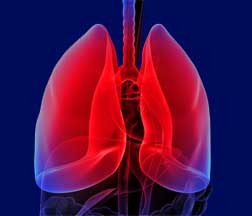Lung Masses and Lung Cancer
Lung cancer is a common cause of cancer death because it is an aggressive tumor and because it does not cause many warning signs until it is large. Unlike other tumors that can be sometimes be detected by the patient, this tumor occurs deep in the chest and cannot be felt by the patient or sensed easily because of the lack of nerves in the lung. This is why about 2/3 of patients have their lung tumor detected at an advanced stage.
Each year there are promising new drugs and other methods devised to treat this disease, but presently the best way to cure lung cancer is to detect it early and remove it with an operation. For the many patients in whom it is not found early, we attempt to control the disease with other methods like radiation and chemotherapy. Surgery may be appropriate later to remove what is left.
A team approach is vital to deal with difficult tumors like lung cancer. This is because multiple treatments sometimes work better than a single cancer therapy. Also lung cancer occurs in a vital life support organ that may have reduced reserve capacity from smoking. Therefore, cancer specialists need to consider how much lung capacity can be safely eliminated along with the tumor. The team considers detailed lung performance tests, carefully searches for signs of tumor spread, and finally recommends standard or new treatments that are being monitored in a clinical trial. For lung cancer we consider newer methods to be the best patient choice because many standard therapies (other than surgery for early disease) have had only limited success.
Each year there are promising new drugs and other methods devised to treat this disease, but presently the best way to cure lung cancer is to detect it early and remove it with an operation. For the many patients in whom it is not found early, we attempt to control the disease with other methods like radiation and chemotherapy. Surgery may be appropriate later to remove what is left.
A team approach is vital to deal with difficult tumors like lung cancer. This is because multiple treatments sometimes work better than a single cancer therapy. Also lung cancer occurs in a vital life support organ that may have reduced reserve capacity from smoking. Therefore, cancer specialists need to consider how much lung capacity can be safely eliminated along with the tumor. The team considers detailed lung performance tests, carefully searches for signs of tumor spread, and finally recommends standard or new treatments that are being monitored in a clinical trial. For lung cancer we consider newer methods to be the best patient choice because many standard therapies (other than surgery for early disease) have had only limited success.
Determining the Best Options for Lung Cancer Patients
As with other cancers, doctors follow the steps of making the diagnosis, evaluating the cancer stage, and determining the best treatment for the patient:
Optimal Testing
|
For patients in whom the diagnosis of lung cancer is not certain, we usually recommend methods to establish diagnoses safely and expeditiously. Our team also carefully considers the risks of tests and treatments for every patient individually to minimize the chance of doing harm. .
|

